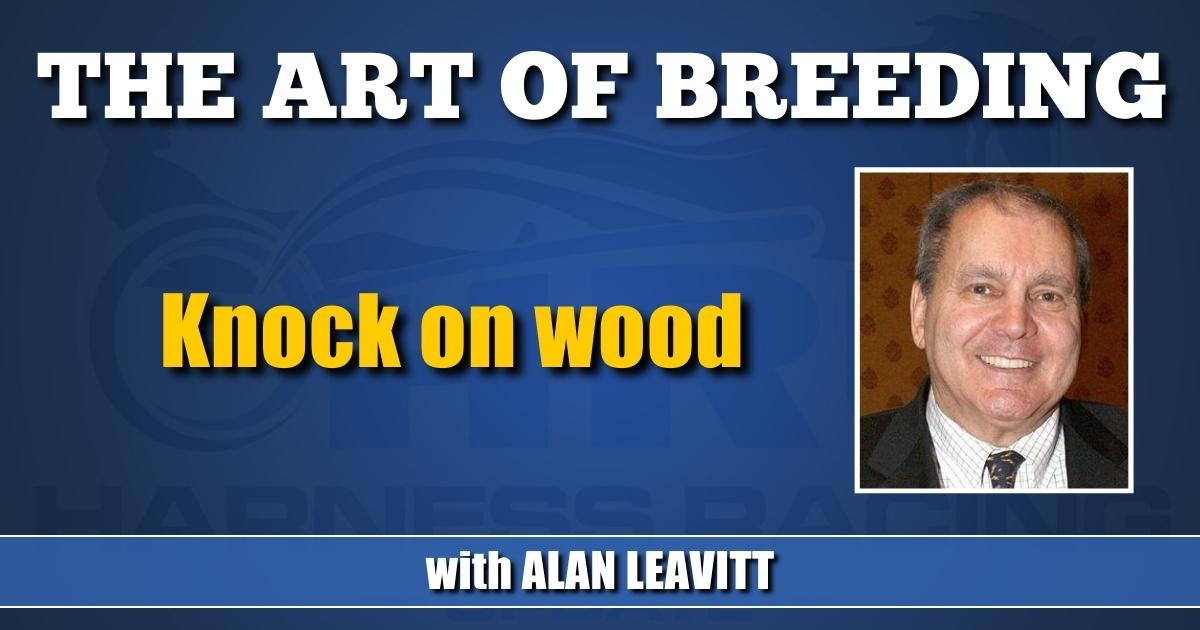Knock on wood
by Alan Leavitt
In the belief that the good trotting sires of the future will come from the 2-year-old stakes winners of today, Gates Hanover caught my eye when he won a division of the Captain Corey Stakes this week at the Red Mile.
Gates Hanover is by Walner and out of Good Common Cents, a fast mare with winnings of $285,178, by Kadabra. He’s trained by the Swedish Fox, Ake Svanstedt, and was driven by Dexter Dunn. About Dunn, I have no nickname; he’s a marvelous driver who probably would win just as many races if he left his whip in the driver’s room.
As for Walner, Gates Hanover’s sire, his dominance as a sire reinforces the belief that 2-year-old brilliance foreshadows success in the stud. He lost only once in a well-managed 2-year-old campaign by Linda Toscano.
As a quick aside, Toscano and I go back to the long ago days when she took care of our great mare, Tarport Hap, for trainer Buddy Regan. Hap died from a heart attack in a race at The Meadowlands, and she’s buried on the infield there. Sleep well, my girl, sleep well.
It’s instructive to look at Walner’s 2-year-old racelines. He liked the front end, which is a racing trademark of most of the horses who went on to be top sires. In his last two starts at 2, he won the Breeders Crown Final by 4-and-a-half lengths and the Kindergarten Final by seven lengths.
He only made two starts for money at 3, and then Toscano stopped with him because of a filled ankle. I suspect that there might be other trainers who would have tried to bring him back, but Toscano respected him too much to take a chance of sullying his reputation.
Good Common Cents, the dam of Gates Hanover, is by Kadabra, who was an outstanding racehorse with a record at 4 of 1:51.3 and earnings of $1,808,775.
At first glance you won’t find many, or maybe any, familiar names in his pedigree except for Speedy Somolli in the third generation. But Kadabra’s dam, Quillo, is an interesting mare when you look closer.
Quillo is by Trottin Happy, by Speedy Somolli, by Speedy Crown, and her dam, Arsenal’s Dynasty, by Arsenal, also by Speedy Crown.
So Quillo is inbred, 3 by 3, to Speedy Crown. As a reminder, when the sum of the two generations in which the same name appears twice is six or less, the horse so bred is properly defined as Inbred.
When the sum of those generations in which the same name appears twice is seven or eight, you have Linebreeding.
When no name appears twice in the first four generations, that pedigree is defined as an Outcross. Virtually all the pacers and trotters of the present day are outcrossed. Which, as I keep repeating until my throat gets sore, opens up a huge opportunity for some smart breeder to do some judicious inbreeding, where gold is to be struck. Or think of it as synergy, a word Serge Godin knows well, where 2 + 2 = 7.
Back to Quillo, whose first three foals not only included the great racehorse and sire Kadabra, but also Money Minded 3, 1:57 2/5 ($167,067), and Lifes a Holiday, 1:54 ($721,659). She had eight more foals, but none of them won as much as $50,000.
Once again, this reinforces the fact that a mare’s best production comes from her first foals. I hasten to say, that’s far from an absolute as someone who will be selling several yearlings in the next few days from mares who have continued to produce stakes winners of equal quality throughout their careers.
There are no absolutes in our business. The best one can do is hope to raise the law of possibility to that of probability. And to do that, the best guide is to recognize the vast difference between a horse’s Phenotype, or physical horse which includes its racing career, and its Genotype, which is its genetic profile. Which explains why a top race mare has less of a chance to produce a top racehorse than an undistinguished race mare from a great maternal family of stakes producers.
Translating a stallion’s Genotype into layman’s terms, think of his genetic range as a deck of playing cards, from a high of Ace to a low card of Two. Walner probably has a speed gene that starts at Ten or even Jack, and goes all the way up to Ace from there.
Because each parent contributes 50 per cent genetically at the time of conception, the speed gene inheritance of the foal is an average of the two speed genes each parent contributes.
So a Walner even from a mare with a low speed gene range will still average out to be a moderately successful racehorse.
This is all familiar territory to anyone who happens to read my pieces from time to time, but because these are basic themes, they bear repeating. I hope.
OLD HOME WEEK IN LEXINGTON
The sale season in now at its height, and the best part of it, from this kid’s perspective, is the chance it offers to see old and new friends in person after many months of long distance communicating.
Just this week I got to shake hands and talk with Bill Donovan, Joe Sbrocco, and John Fedora, which made my day. I also had a quick visit from Julie Miller, who is as charming as she is gifted as a trainer.
And then, as the icing on my cake, my good friend from Sweden, Robert Lindstrom, paid a visit to look our stock over. There is no one sharper on the international scene, and a lot of the success the Swedes are having here is courtesy of Lindstrom. He is close to Ake Svanstedt, and together they make the right moves on a regular basis.
So that’s the best part of the sales season, and I’m happily looking forward to more of the same as soon as we move into Barn 3. Which, come to think of it, has always been my lucky number, and it can’t quit on me this close to the end. And I’ll also knock on wood, just to cover all my bases. No use taking any unnecessary chances.
















